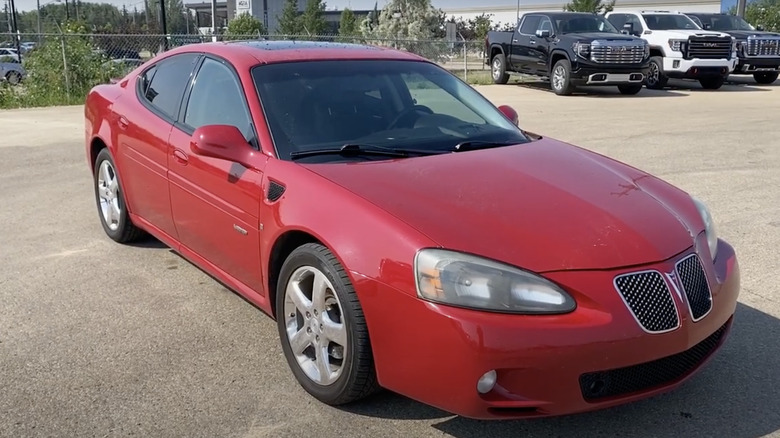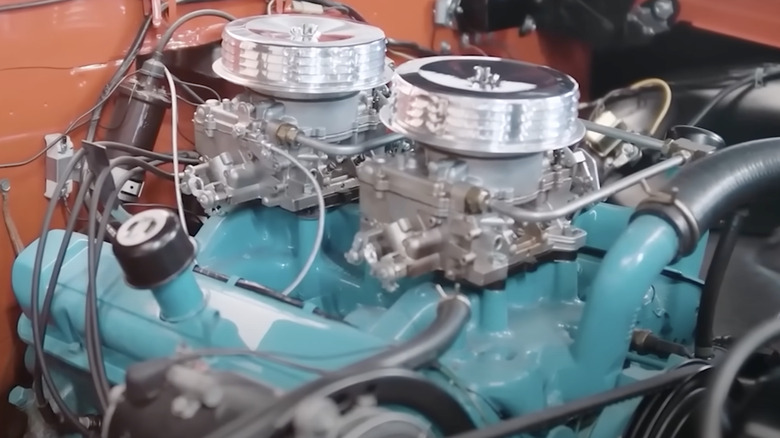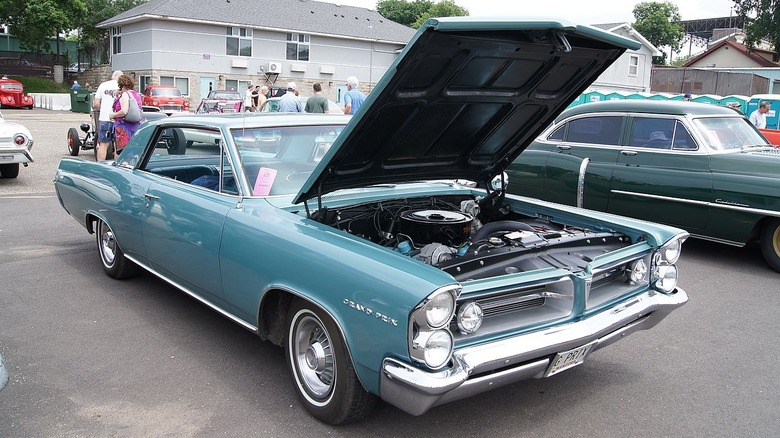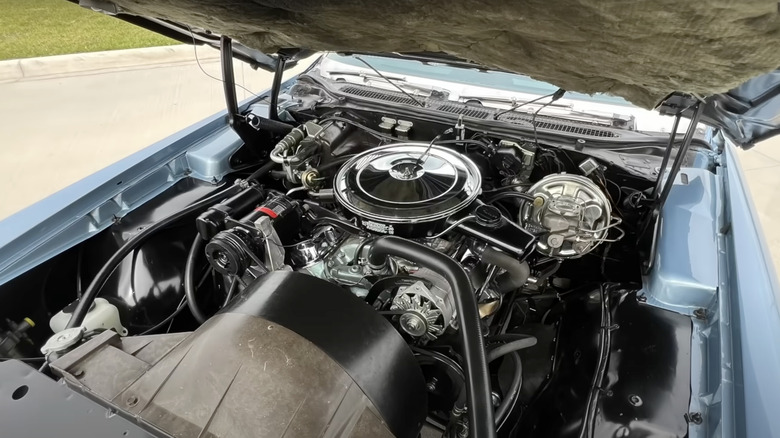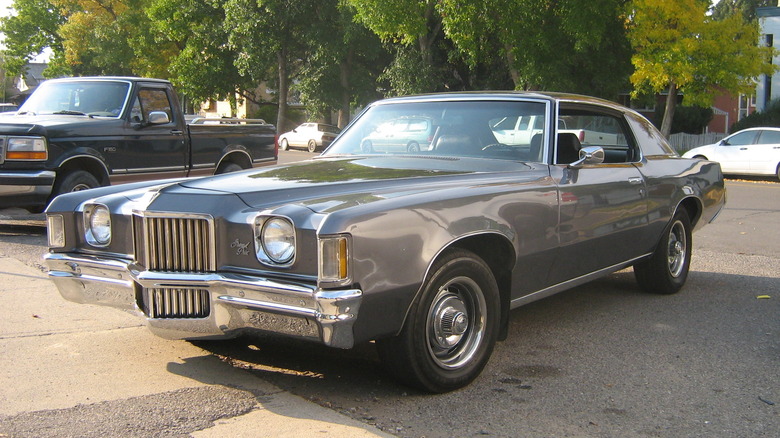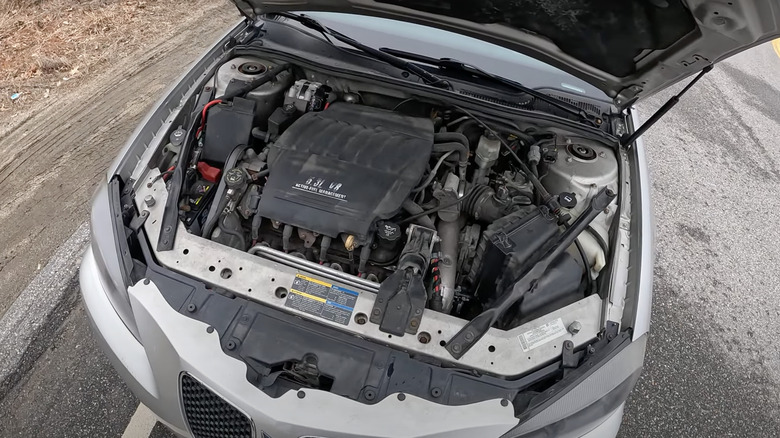5 Of The Most Powerful Engines Ever Put Into The Pontiac Grand Prix
Pontiac's long run as an automaker began with the Six in 1926 and lasted through 2009, when the brand became a casualty of GM's bankruptcy proceedings. During its heyday, Pontiac produced potent and popular models like the Firebird and its high-performance cousin, the Trans Am. One of Pontiac's longest-running models was the Grand Prix, which went through seven generations during its 40-plus years in production. Over time, the Grand Prix evolved from a well-appointed sports coupe to a true '70s land yacht and finally to a still-powerful mid-size model.
During that stretch, the Grand Prix kept true to its racing-inspired name with a series of high-powered engines, many of which churned out impressive horsepower numbers. Here are a handful of the most potent powerplants General Motors used in the Grand Prix, plus some additional information regarding just what that output meant for the model's performance specs as it cruised through almost a half-century of Pontiac's history.
The 421-inch Super Duty was a 400-horsepower monster
Pontiac didn't wait to grace the Grand Prix with a big, burly V8. When it debuted in 1962, most Grand Prix buyers drove home with a variant of the same 389 cubic inch engine that would later go in the 1964 GTO, but lucky late-year customers had a more powerful option. The Super Duty package wasn't widely advertised and added $2,250 to the cost of the model (equal to over $23,000 today). For that hefty sum, buyers got a 421-inch V8 topped with two Carter four-barrel carburetors.
That boosted output to 405 horsepower, but the price was prohibitive to most buyers. Only 16 customers opted for the Super Duty package in 1962, and it was dropped the following year when General Motors abandoned its factory racing program. Of the 16 originally produced, Mecum Auctions estimates that only five have survived to this day. One that was part of the Milton Robson Collection sold in 2010 for $181,500, and another popped up via Mecum a little less than three years ago.
The standard-issue 421 was no slouch either
You didn't need to buy a $2,000 option package to get the 421 cubic inch V8 in your first-generation Grand Prix. The most powerful engine in 1963 and 1964 — after the Super Duty option was cut — was the same 421-inch beast topped with three two-barrel carbs in Pontiac's "Tri-Power" setup. This configuration yielded 370 horsepower while opting for one four-barrel carburetor put 353 horses under the driver's right foot. Both 421 engine options cost around $400, which equals roughly ten times that amount today.
In 1964, the tri-power 421's output dropped to an even 350 horses, and the four-barrel version produced 320 horsepower, leaving the 1963 Tri-power 421 as the most potent Grand Prix engine other than the Super Duty. That configuration got the Grand Prix from 0-60 in 6.6 seconds in Motor Trend's testing, a mark that was .6 seconds slower than that year's Chevy Corvette. The 1962-1964 Grand Prix isn't especially easy to find on the secondhand market these days. Classic.com reports only 46 sales from those three model years since 2019, with an average price of just under $32,000.
The 1969 and 1970 Grand Prix featured monstrous V8s
The muscle car era was in full swing by the end of the 1960s, and Pontiac division head John Delorean refused to take a back seat when it came to developing the second-generation Grand Prix. It debuted in 1969, with a long hood, powerful V8 options, and model designations borrowed from Duesenbergs of yore. The standard J version got a 400 cubic inch V8 that produced 350 horsepower, while SJ Grand Prix models had one of two 428-inch V8s. The regular version produced 370 horsepower, and the High Output variant made 390 ponies.
The H.O. Grand Prix SJ could get from 0-60 in under seven seconds and turn quarter-mile times in the mid-14s, but the 428 yielded to a 370-horsepower, 455 cubic inch V8 for the 1970 model year. Soon after that, a switch from gross to net horsepower ratings and the oil crisis flattened the tires on muscle car development. By then, Delorean had left Pontiac for Chevrolet, leaving the 1969 Grand Prix SJ as a bold punctuation mark on his Pontiac years.
The 1971 model's 455 made 325 horsepower
1971 was a transition year for many automakers with regard to measuring horsepower. A ban on leaded fuel was also looming on the horizon, forcing engine designers to build lower-compression powerplants. Pontiac managed to slip some impressive stats under the wire with the 1971 Grand Prix, though. That year's SJ model came with the 455 cubic inch V8, tuned to make 325 horsepower and 455 pound-feet of torque.
J versions of the Grand Prix got a 400 cubic inch engine that made nice even numbers of 300 horsepower and 400 pound-feet of torque. When calculations shifted fully to net horsepower in 1972, the SJ's 455-inch V8's official output dropped to 250 horsepower and 375 pound-feet. The 400 cubic engine produced that same 250 horsepower but with just 325 pound-feet of torque. By the time the 1974 models were rolling onto dealership lots, the oil embargo was in full swing, and automakers and buyers had different priorities. For 1974, the 400 cubic inch V8 was down to 225 horsepower, while the SJ's 455-inch engine held steady at 250 horses.
The 2008 Grand Prix GXP was a 303-horsepower swan song for the brand
V8s disappeared from the Grand Prix later in the '70s, but the model persisted into the 21st Century. For 2005, Pontiac introduced the Grand Prix GXP, which came with a 5.3-liter LS series engine. It produced 303 horsepower and 323 pound-feet of torque, bringing the Grand Prix back into performance car territory. GM's engine team had to reconfigure the V8 to fit it under the hood of the new Grand Prix, and the model's four-speed automatic transmission was beefed up to handle the engine's torque output.
Car and Driver tested the Grand Prix GXP at 5.7 seconds from 0-60 and 14.3 seconds over a quarter mile, while observing fuel consumption of 14 miles per gallon. That was a far cry from Pontiac's claimed figures of 18 in the city, 27 on the highway, and 21 combined. The Grand Prix GXP lasted through 2008, at which point the Pontiac brand was in its final moments.
